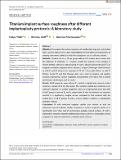DSpace Repository
Titanium implant surface roughness after different implantoplasty protocols: A laboratory study
- DSpace Home
- →
- Web Of Science
- →
- Web Of Science
- →
- View Item
JavaScript is disabled for your browser. Some features of this site may not work without it.
| dc.contributor.author | Yildiz, Hulya
|
|
| dc.date.accessioned | 2024-05-03T11:29:20Z | |
| dc.date.available | 2024-05-03T11:29:20Z | |
| dc.date.issued | 2022 | |
| dc.identifier.issn | 2057-4347 | |
| dc.identifier.uri | http://hdl.handle.net/11547/11670 | |
| dc.description.abstract | Objective: To compare the surface roughness of sandblasted, large grit, acid-etched (SLA) surfaced titanium discs, after implantoplasty (IP) with different combinations of rotating instruments without or with the subsequent use of a silicone polisher. Methods: Titanium discs (n = 12 per group) with an SLA surface were treated with the following IP protocols: (1) Tungsten carbide bur sequence from company 1 (Komet Dental) without or with polishing (P) with a silicone polisher (Brownie (R)), (2) tungsten carbide bur sequence from company 2 (Hager & Meisinger GmbH) without or with P, and (3) diamond bur sequence (125, 40, 15-mu rn grit) without or with P. Pristine turned (T) and SLA titanium discs were used as negative and positive controls, respectively. Surface roughness measurements were taken with a contact profilometer rendering R-a and R-z values. Results: All IP protocols, even without P, resulted in significantly reduced surface roughness compared to the SLA group. The tungsten carbide bur protocols, even without P, resulted in a surface roughness similar to or significantly lower than that in the T group in terms of R-a and R-z, respectively. IP with the diamond bur sequence resulted in a significantly rougher surface compared to that achieved with the carbide burs. In all IP groups, P with a silicone polisher resulted in a significantly smoother surface. Conclusions: IP with dedicated tungsten carbide burs without or with the subsequent use of a silicone polisher resulted in a surface roughness similar to or significantly lower than that of commercially available turned surfaces. IP with a diamond bur sequence required additional polishing to achieve a comparable surface roughness to that of commercially available turned surfaces. | tr_TR |
| dc.language.iso | en | tr_TR |
| dc.title | Titanium implant surface roughness after different implantoplasty protocols: A laboratory study | tr_TR |
| dc.type | Article | tr_TR |
Files in this item
This item appears in the following Collection(s)
-
Web Of Science [1152]
